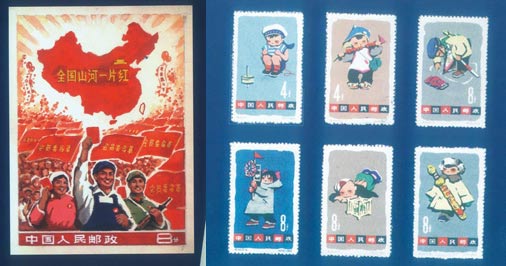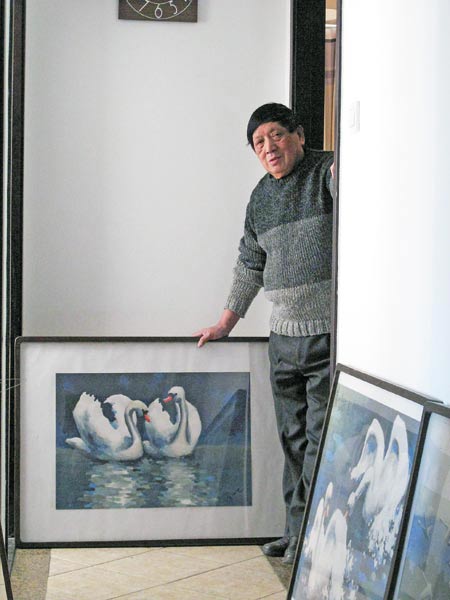
 |
|
Wan Weisheng's well-known stamp designs include The Whole Country Is Red series (left) during the "cultural revolution" and his Children series (right). |
 |
|
Wan Weisheng, 79, shows off his oil depictions of swans, which are also subjects of his stamp designs. Jiang Dong / China Daily |
Celebrated stamp designer Wan Weisheng recounts his past works and hopes for the medium's future in the Internet era. Zhu Linyong reports in Beijing.
Celebrated stamp designer Wan Weisheng doesn't hesitate to call the new postage stamp celebrating the Year of the Dragon "mediocre".
"The dragon appears too vicious," he says.
"Why not make it cute and friendly?"
Then again, the 79-year-old doesn't believe his 1968 stamp, which set the world record for Chinese stamp sales at a Hong Kong auction at HK$3.68 million ($474,000) in 2009, was his best.
Wan believes it became famous simply because of market speculation and the popularity of "red stamps" and those created during the "cultural revolution" (1966-76).
The stamp comes from the The Whole Country Is Red series he was assigned to create. It features red flags, balloons and the little red book of late Chairman Mao Zedong's quotations waved by joyous masses. But Taiwan, a renegade province of China, was left uncolored. The stamp was discontinued after only six copies were sold on its release day.
Wan has created about 150 editions of 40 popular stamps, postcards, first-day covers and souvenir sheets.
Some of his most dazzling were created for the 2008 Beijing Olympics, the 2010 Shanghai Expo and the souvenir sheets that traveled to outer space on the Shenzhou V - China's first manned spacecraft - Oct 16-17, 2003.
Wan's personal favorites are a 1957 stamp series featuring children, stamps showing the Great Wall in 1979 and a set featuring swans released in 1983.
He was disappointed when he was assigned as a graphic designer of China Philately Corp in Beijing after graduating from the Northeast China School of Fine Arts (now Lu Xun Academy of Fine Arts) in Liaoning's provincial capital Shenyang in 1955.
"I feared my life would be wasted drawing tiny pictures that occupy envelopes," he recalls.
But he changed his mind after realizing his creations were printed and circulated in the millions.
"Stamps connect the artist with people around the world and are an art form that influence the public sphere," he says.
"I'm proud of being a professional stamp designer."
Wan's retrospective solo show was staged last month at the Gallery of the National Painting Academy in Beijing.
Wan says he feels it's his duty to produce decent works and often travels to rural and urban communities to find inspiration.
He got the idea for the series depicting children when riding his bike in Beijing and saw children playing with toys in the hutong. So, he dropped his idea of creating political works.
The works showing the carefree children became some of his most popular and sold millions.
"What moves the artist moves viewers, too," Wan says.
"Only when a graphic designer works with emotions can his creations win users' and collectors' hearts."
He recalls a family of four swans drew crowds when it temporarily settled in Beijing's Yuyuantan Park in the winter of 1980.
But poachers shot one of the fowl dead and the others left days later.
A crowd of angry Beijingers staged a burial for the swan at the park and denounced the rarely seen bird's killing. Wan was among the mourners.
He was saddened by the scene and sounds of the other family members singing farewell to the dead swan. He felt the urge to include the graceful swan on stamps.
Wan braved the winter chill to create onsite sketches in the park and also visited the Beijing Zoo's swans.
A week later, he created a set of four swan stamps philatelists consider "classics".
Some philatelists who have collected hundreds of Wan's designs even offered to finance his exhibitions, stamp album publications and a museum of his stamps.
His fan base has continued to grow, even after his retirement and shift to oil painting.
Wan donated his stamps, drafts, paintings and books to his hometown, Fujian province's Quanzhou, in 2001.
The Wan Weisheng Stamp Art Museum was founded two years later, with support from local governments and philatelists.
The 3,500-sq-m building is the country's first dedicated to a single stamp designer.
"Stamps are losing their practical function in the Internet era," Wan says.
"But I believe stamps, post cards and souvenir sheets can withstand the test of time because of their unique artistic, cultural and historical values."